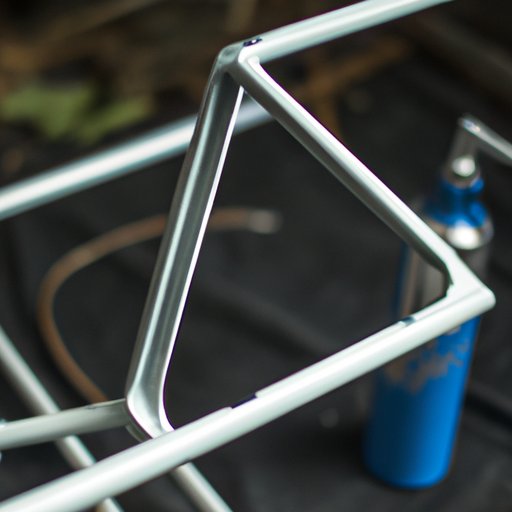Introduction
Painting a bike frame is a great way to customize the look of your bicycle. Whether you want to make a statement or just give your bike a fresh new look, painting the frame is an easy and affordable way to do it. But before you get started, it’s important to understand what’s involved in the process and how to do it right.
Bike frame painting is the process of applying a protective coating to the frame of a bicycle. This coating, usually paint, helps to protect the frame from corrosion and gives it a unique look. There are many different types of paints available, ranging from traditional enamel to modern spray paints.
Painting a bike frame can also help preserve the value of the bike. If done properly, it can help protect the frame from rust, scratches, and other damage that can occur over time. It can also make an older bike look brand new again.
Step-by-Step Guide to Painting a Bicycle Frame
Painting a bike frame is not as difficult as it may seem. With the right materials, tools, and techniques, anyone can do it. Here’s a step-by-step guide to painting a bicycle frame.
Materials and Tools Needed
Before you begin, you’ll need to gather the necessary materials and tools. You’ll need sandpaper, primer, paint, sealant, masking tape, a paintbrush, a roller, and a drop cloth.
Preparing the Frame for Painting
The first step in painting a bike frame is to prepare it for painting. Start by removing any dirt or debris from the frame using a damp cloth. Then use sandpaper to roughen up the surface of the frame. This will help the primer and paint adhere better. Once the frame is clean and dry, you can apply the primer.
Choosing the Right Paint
Once you’ve prepped the frame, you’ll need to choose the right paint. There are several types of paint available, including enamel, acrylic, and spray paint. Each type has its own advantages and disadvantages, so it’s important to do some research to find the best option for your project.
The Best Technique for Painting
When painting a bike frame, it’s important to use the right technique. The best technique is to use a brush or roller to apply the paint in thin coats. This will help ensure that the paint adheres evenly and lasts longer. Avoid painting too thickly, as this could result in drips, runs, and sags.
DIY: How to Paint a Bicycle Frame Using Spray Paint
Spray painting is a popular method for painting a bike frame. It’s fast, easy, and produces a professional-looking finish. Here’s how to spray paint a bicycle frame.
Advantages of Spray Painting a Bicycle Frame
Spray painting offers several advantages over other methods of painting. It’s faster and easier than brushing or rolling paint on. It also provides a smoother, more even coat of paint. Finally, spray paint is less likely to drip or run.
Steps for Spray Painting a Bicycle Frame
To spray paint a bicycle frame, first cover the area around the frame with a drop cloth. Next, use masking tape to cover any parts of the frame that you don’t want painted. Once the frame is prepared, shake the can of spray paint for at least one minute. Then, holding the can 8-10 inches away from the frame, apply the paint in thin, even coats. Allow each coat to dry before applying the next. After the final coat of paint has dried, use a clear sealant to protect the paint and make it last longer.

Troubleshooting Common Problems When Painting a Bike Frame
Even with the right materials and technique, there are still some common problems that can occur when painting a bike frame. Here are some tips for troubleshooting these issues.
Dealing with Drips, Runs, and Sags
If you’ve applied too much paint, you may end up with drips, runs, and sags. To fix this problem, wait for the paint to dry, then lightly sand the area. This should remove any excess paint and help even out the finish.
Fixing Uneven Coverage
If the paint isn’t covering the frame evenly, it could be because you didn’t apply enough paint. In this case, wait for the paint to dry and then apply another coat. Make sure to apply the paint in thin, even coats to avoid drips and runs.
Removing Paint from Other Parts of the Bike
If you accidentally get paint on other parts of the bike, such as the tires or handlebars, don’t worry – it’s easy to remove. Start by wiping off any excess paint with a damp cloth. Then use rubbing alcohol or nail polish remover to remove any remaining paint.
Conclusion
Painting a bike frame is a great way to customize the look of your bicycle. With the right materials, tools, and techniques, anyone can do it. To get started, gather the necessary materials and tools, prep the frame, choose the right paint, and apply it using the best technique. If you encounter any problems along the way, don’t hesitate to troubleshoot them.


